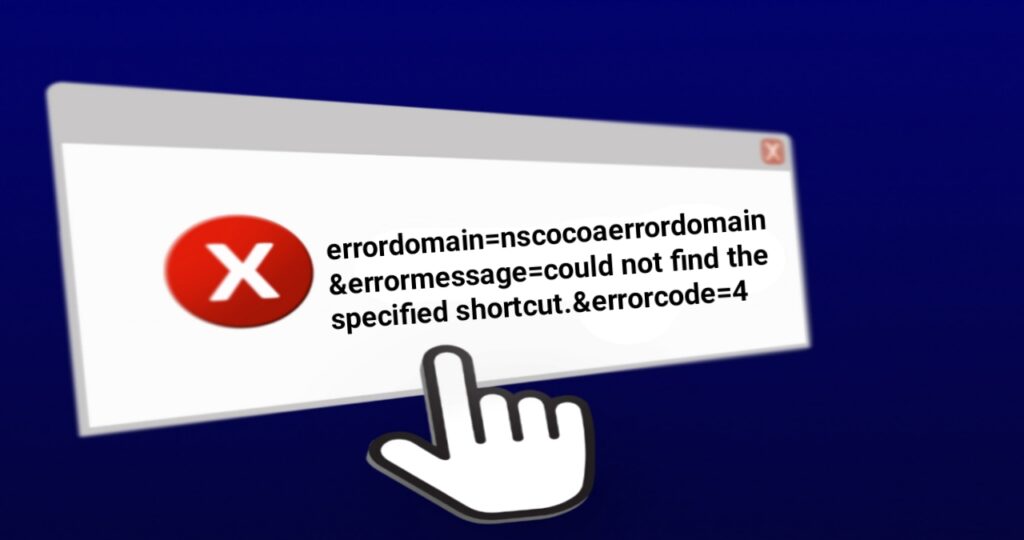Finally, Fix the errordomain=nscocoaerrordomain&errormessage=could not find the specified shortcut.&errorcode=4 Error for Good: A Thorough Explanation and Troubleshooting Process

Have you ever tried opening an app or file on your Mac, only to see the confusing error message errordomain=nscocoaerrordomain&errormessage=could not find the specified shortcut.&errorcode=4 ? You’re not alone. This error indicates that macOS failed to locate a shortcut it expected to find. But what does it mean, and how can you resolve it?
This in-depth article explores the root cause of the “specified shortcut not found” error, how it impacts your Mac and the best ways to troubleshoot and prevent future issues. By the end, you’ll clearly understand shortcuts and be equipped to solve this problem for good. Let’s get started!
What is a Shortcut, and What Role Does it Play?
- To understand the error , we must first understand a shortcut in computing terms. A shortcut refers to a file or link pointing to another file’s location or program on the computer. It acts as a pointer that allows the operating system and users to access the target item more quickly.
macOS relies heavily on shortcuts behind the scenes. When you open an app from the Dock or launch a document from Finder, you use a shortcut evethingsn if you don’t see the file. They allow macOS to keep track of installed programs and files so they remain readily available.
So, shortcuts are critical signposts that tell macOS where to find the you use daily on your Mac. When one goes missing, it throws the entire system off course, preventing the linked item from opening as expected.
Root Causes of the Missing Shortcut Error
Now that we know shortcuts are vital, what causes them to disappear in the first place? Here are some common reasons:
- File Corruption – Constant reading/writing wears files down over time, making them unreadable. Shortcuts are prone to this.
- Deletion – Users sometimes accidentally delete shortcut files without realizing it.
- Software Bugs – Edge case bugs in macOS or other apps could impact how shortcuts register.
- Hardware Issues – Faulty storage drives may struggle to locate/read files like corrupted shortcuts.
Understanding the root causes helps target your troubleshooting approach. In summary, the error means macOS expects a specific shortcut but can’t find it anywhere – time to investigate!
Top Tactics for Resolving the Missing Shortcut Problem
Now that we understand what’s happening, here are some of the most effective troubleshooting methods:
Recreate the Missing Shortcut
Determine which app/file won’t open due to the error and recreate its shortcut manually. Right-click the item and select “Make Alias” to generate a new shortcut file.
Repair Disk Permissions
Open Disk Utility and select your startup drive. Click “First Aid” to scan and repair permissions, which could prevent macOS from finding files like shortcuts.
Rebuild the Launch Services Database
This database tracks installed apps/shortcuts on your Mac. Rebuilding it through the Terminal often resolves issues:
`sudo touch /Library/LaunchAgents/com.apple.launched.peruser.501/.`
Update macOS
Outdated operating systems frequently have bugs – make sure your Mac is running the latest public release of macOS.
Check Console Logs
Open the Console and filter by “process name” for clues about what was triggering the specific missing shortcut.
Reinstall Corrupt Apps
Altogether, remove and reinstall any programs linked to persistently missing shortcuts.
As a last resort, back up your files, erase storage, and perform a clean macOS installation to solve deeply tangled problems.
Following the tips above has resolved this error for countless Mac users. The right approach usually becomes clear once you determine which shortcut is defective.
Avoiding Future Shortcut Issues
While solving immediate problems takes priority, it’s wise to consider preventive steps:
- Keep regular backups so file loss isn’t catastrophic due to human error or hardware faults. Time Machine makes this effortless.
- Only download apps from reputable developers through the Mac App Store to reduce threats from malware and unstable code.
- Use antivirus software to routinely scan for and remove malicious files that manipulate macOS components like the shortcuts database.
- Keep macOS and all apps up-to-date through Software Update. New releases frequently include important fixes to recently discovered bugs.
- Monitor storage usage and avoid filling drives almost entirely—entire disks slow performance and strain file systems.
- Consider an SSD upgrade for older Fusion Drive or HDD Macs prone to physical storage issues over time.
Taking a proactive, defensive approach helps discourage stubborn shortcut errors from cropping up repeatedly down the road. You also have more resources available if minor problems do occur.
Read Also Our This Post: Mastering the Art of Drawing:cul23ybyzfm= Basketball
Frequently Asked Questions About This Specific Error
We’ll conclude by addressing some other questions readers may have:
Q: How do I know which shortcut is missing and where it should be?
A: The error includes detailed clues like the app name trying to open. Search for that app, right-click it and follow its currently defined shortcut path in Finder.
Q: What if I’ve tried everything and nothing works?
A: As a nuclear option, back up all data, erase storage in Disk Utility, and perform a fresh macOS installation. But first, double-check console logs for any underlying clues.
Q: Should I be concerned about a more significant macOS problem?
A: A single instance may be an innocent glitch, but multiple persistent shortcut breakages could point to disk issues needing attention. Monitor symptoms closely.
Q: Why are these errors so cryptic and hard to understand?
A: Apple aims to make shortcut problems rare, and this error message focuses on the technical aspect rather than user-friendliness since it’s rare.
With diligence following best practices laid out here, you’ll be well equipped to independently understand and solve “specified shortcut not found” errors whenever they arise. Let me know if you have any other questions!

I’m publisher on vents today if anyone want post on our website then do contact







